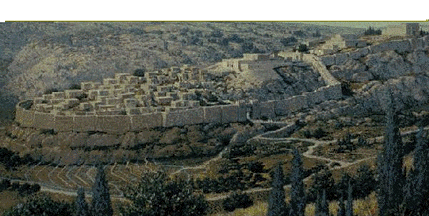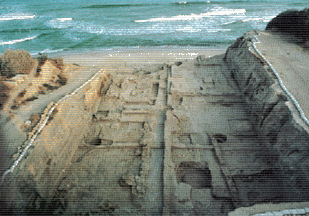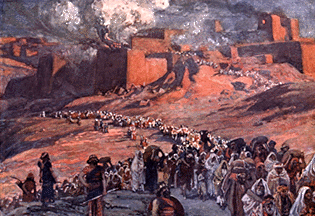|
In 609 BC Necho rushed north to assist his former rivals, the Assyrians. His army would have to march through Judah if he
were to engage the Babylonians. Judah's King Josiah decided to block the Egyptian advance even though Necho sent him a message
that he only wanted to pass through the land and did not intend to attack Judah. Nevertheless, in the summer of 609 BC, on
the plain of Mediggo, Josiah's troops attacked the Egyptian forces and were decisively defeated. Josiah was killed in this
battle.
When the Egyptians arrived at the former Hittite capitol Carchemish on the west bank of the Euphrates, they were joined by
the Assyrians and marched on Harran where they were soundly defeated and driven back to Carchemish. The following year the
Egyptians and the Assyrians once again attacked the Babylonians, who were now led by Nebuchadnezzar II, the son of king Nabopolassar.
At the battle of Carchemish the Babylonians gained a decisive victory in 605 BC and the remnants of the Egyptian army withdrew
back into Philistia and Judah. On the return trip Necho set up a puppet king (Jehoiakim) who was loyal to Egypt.
After Carchemish, Nebuchadnezzar II campaigned throughout most of Philistia, completely destroying every city in his path.
Unfortunately for Philistia and Judah, they failed to recognize the strength of the Babylonians and had decided to ally themselves
with Egypt for protection. Despite several pleas for help, the Egyptians never responded.
Babylonians storming Tyre
Nebuchadnezzar's primary goal was Egypt and he wanted to send a message with his scorched earth policy. Late in the year he
decided to strike at the primary seaport of the Phillistines--Ashkelon. It was a well fortified city but was completely devastated
ruins of Ashkelon on Medeterranian
partial excavation of Ashkelon Bazaar
According to the fragmentary Babylonian Chronicle written in cuneiform:
...Nebuchadnezzar marched to the city of Ashkelon and captured it in the month of Kislev (November/December). He captured
its king and plundered it...he turned the city into a mound and heap of ruin...
From Ashkelon, Nebuchadnezzar marched on Ekron and also reduced it to rubble. Judah surrendered to Babylon in 603 BC and thus
Jerusalem was spared annihilation. Even though Judah had submitted to Babylon, it nevertheless lost no opportunity to throw
off the yoke when it saw the chance. That chance came in the winter of 601/602 BC when Nebuchadnezzar attacked Egypt proper.
This campaing led to heavy losses on both sides and Nebuchadnezzar retreated back to Babylon empty handed. Encouraged by this
defeat, the leaders of Judah rebelled and defected to the Egyptians...another unwise and vacillating decision. The Babylonians
were unable to immediately retaliate against Judah because they were occupied in rebuilding their army and their chariot force.
However in the winter of 598/597 BC, Nebuchadnezzar attacked Judah with a tremendous force, probably as a warning to Egypt
and her other allies. Judah's wise decision to surrender probably spared the destruction of Jerusalem although 10,000 of her
inhabitants were exiled to Babylon.
Jerusalem exiles
In 594/593 BC Judah once again made an unfortunate decision. Its new puppet king and last monarch, Zedekiah, got together
a coalition of petty states such as Edom, Moab and Amon and the cities of the Phoenecian coast to stand against Babylon. It
seems that once again Egypt conned Judah into taking this stance. In the winter of 589/588 BC, Nebuchadnezzar laid seige to
Jerusalem for two and a half years. She capitulated in 586 BC, mostly due to famine. The city was razed and the palace and
temple were totally destroyed.
|
|
| King Jehoiakim led away in chains |
This marked the end of Judah for years to come. Babylon would remain in control to the Mediterranean Sea until the arrival
of the Persians. These events were recorded yearly in cuneiform in the Babylonian Chronicles which were excavated fairly recently.
Portion of the Babylonian Chronicle describing the fall of Jerusalem
|











